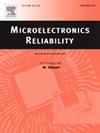Enhancing long-term thermal reliability of sintered joints through the use of silver-coated copper particles
IF 1.6
4区 工程技术
Q3 ENGINEERING, ELECTRICAL & ELECTRONIC
引用次数: 0
Abstract
This study investigated the long-term thermal reliability of a sintering paste incorporating Ag-coated Cu (Cu@Ag) particles to inhibit copper oxidation. After thermal aging, shear strength increased in Cu@Ag joints under inert and air atmospheres, showing different microstructures. In an inert atmosphere, a Cu![]() Cu sintering network emerged, while in air, atmosphere facilitated the formation of a Cu2O network encasing the Cu@Ag particles within the sintered joint. Subsequent analyses of the sintered joint microstructures, post long-term thermal reliability testing and differentiated by pressurization and non-pressurization in air, unveiled further disparities. Pressurized samples exhibited a dense sintering network within the joint microstructure that restricted oxygen access to copper, leading to a thin Cu2O shell encapsulating the copper particles. Conversely, non-pressurized samples featured a porous sintering network, enabling direct contact between copper and oxygen during thermal aging and the formation of a significant Cu2O bulk network. The fracture modes also varied between the pressurized and non-pressurized samples, with ductile fracture observed in the former and brittle fracture in the latter. Based on these findings, this study proposes an optimal microstructure for the Cu@Ag paste, promoting the use of a Cu@Ag sintering paste as a cost-effective and antioxidative approach for enhancing thermal reliability.
Cu sintering network emerged, while in air, atmosphere facilitated the formation of a Cu2O network encasing the Cu@Ag particles within the sintered joint. Subsequent analyses of the sintered joint microstructures, post long-term thermal reliability testing and differentiated by pressurization and non-pressurization in air, unveiled further disparities. Pressurized samples exhibited a dense sintering network within the joint microstructure that restricted oxygen access to copper, leading to a thin Cu2O shell encapsulating the copper particles. Conversely, non-pressurized samples featured a porous sintering network, enabling direct contact between copper and oxygen during thermal aging and the formation of a significant Cu2O bulk network. The fracture modes also varied between the pressurized and non-pressurized samples, with ductile fracture observed in the former and brittle fracture in the latter. Based on these findings, this study proposes an optimal microstructure for the Cu@Ag paste, promoting the use of a Cu@Ag sintering paste as a cost-effective and antioxidative approach for enhancing thermal reliability.
求助全文
约1分钟内获得全文
求助全文
来源期刊

Microelectronics Reliability
工程技术-工程:电子与电气
CiteScore
3.30
自引率
12.50%
发文量
342
审稿时长
68 days
期刊介绍:
Microelectronics Reliability, is dedicated to disseminating the latest research results and related information on the reliability of microelectronic devices, circuits and systems, from materials, process and manufacturing, to design, testing and operation. The coverage of the journal includes the following topics: measurement, understanding and analysis; evaluation and prediction; modelling and simulation; methodologies and mitigation. Papers which combine reliability with other important areas of microelectronics engineering, such as design, fabrication, integration, testing, and field operation will also be welcome, and practical papers reporting case studies in the field and specific application domains are particularly encouraged.
Most accepted papers will be published as Research Papers, describing significant advances and completed work. Papers reviewing important developing topics of general interest may be accepted for publication as Review Papers. Urgent communications of a more preliminary nature and short reports on completed practical work of current interest may be considered for publication as Research Notes. All contributions are subject to peer review by leading experts in the field.
 求助内容:
求助内容: 应助结果提醒方式:
应助结果提醒方式:


